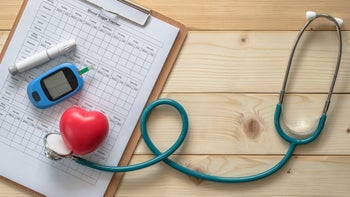
How to Check Blood Sugar at Home: Tips on Choosing a Device, Reading Results
Key takeaways:
Most people living with diabetes monitor their blood glucose (sugar) at home.
There are two devices to track glucose levels: a blood glucose meter (glucometer) and a continuous glucose monitor (CGM). Your diabetes care team can help you choose what’s best for you.
You can reduce diabetes-related complications by checking your blood glucose or wearing a CGM, reviewing the data, and making changes to keep your blood glucose in range.
Table of contents
A glucose meter (glucometer) is a small, handheld device that people use for blood sugar measurement at home. It requires a tiny drop of blood from a finger to produce real-time results in seconds.
With advances in technology, continuous glucose monitors (CGMs) have become another option. CGMs are wearable devices that use a sensor under the skin to measure glucose in the body’s tissues 24 hours a day. They don’t require multiple finger pricks per day like traditional glucometers. But are they suitable for everyone? How do you choose between the two?
Whichever approach you pick, know this: Experts recommend both traditional glucometers and CGM as daily management tools for anyone with diabetes. When used correctly, and regularly, they can accurately identify out-of-range glucose values and help you reduce the risk of diabetes-related health complications.
Save on popular GLP-1 Agonists
Take control of your health. With GoodRx, you may be eligible to save even more on popular treatments.

How to check your blood sugar at home
You can check your blood glucose with a glucometer in four easy steps:
Clean and dry your hands.
Place a test strip in the glucometer.
Poke your finger with a lancet (or small needle).
Apply a drop of blood to the test strip.
After viewing and recording your result, safely discard your materials. You can use a sharps container for needles and wrap up used test strips to prevent anyone else from coming into contact with blood or needles.
How often you test your blood glucose depends on the type of diabetes you have and the medications you take. Your diabetes care team will help you create a plan that works for you. People living with diabetes typically check their glucose at regular times throughout the day:
First thing in the morning
Before meals
2 hours after meals
At bedtime
With signs of high or low blood sugar
During and after exercise
What should my blood sugar levels be?
Glucose values are always changing, but target values stay the same. As a general rule, aim for the American Diabetes Association (ADA) guidelines, unless your diabetes care team has given you other standards to follow.
How much does a continuous glucose monitor (CGM) cost? Find out how much you can expect to pay for a CGM — and whether insurance will cover the cost.
What to know about over-the-counter CGMs: What are the differences between over-the-counter and prescription CGMs? And can anyone use them? Get expert answers to these questions and more.
Need help with diabetes supply costs? See what Medicare covers and how to save on diabetes supplies, services, and more.
When recommending target values, your healthcare team will consider your personal medical history and other factors. Blood sugar target levels may vary from person to person, depending on:
Age
Activity level
Any other health conditions
Your type of diabetes
In general, for a nonpregnant adult with diabetes, blood glucose targets fall into these ranges:
Preprandial or before meals: 80 mg/dL to 130 mg/dL
Postprandial or 1-2 hours after starting a meal: 180 mg/dL or lower

It’s important for people with diabetes to check their hemoglobin A1C as well as blood glucose levels. This measures average glucose levels over the past 2 to 3 months and should be done at least twice a year. Your diabetes care team will often provide recommendations for testing and a target range.
Blood glucose monitors: What are the options?
Before choosing a device to check your blood glucose, know your options. Check out the ADA’s Consumer Guide to learn about glucometer and CGM choices. You can select those you’re interested in and look at side-by-side comparisons.
Depending on your health insurance, upfront and ongoing costs of glucometers and CGMs will vary. The good news is most companies give their glucometers away for free.
Glucometers and CGMs are both used for measuring blood sugar levels in the body — but that’s where the similarities end.
Glucometers
A glucometer is a device that checks blood glucose levels from a single drop of blood. It requires you to prick your finger and catch a drop of blood on a test strip. The device measures your blood glucose level from the test strip — but you have to manually prick your finger and insert the test strip into the machine.
It’s up to you how often you do this, but most people with diabetes check their glucose levels three to four times a day. There’s no limit to how often you can use it, but it requires a fresh drop of blood and a fresh test strip every time.
You’ll get blood glucose results within seconds. So you can know if your glucose is low, high, or within range. Most devices have options to store results over time, making it easy to see patterns and share these with your healthcare team.
CGM devices
A CGM measures glucose in the body’s tissues through a skin sensor. It can take readings continuously, around the clock. After initial approval in 2000, CGMs have become more accurate over time. Some older models may require one finger stick to calibrate the device, but for the most part, there are no needles required with CGMs.
You can self-insert CGM devices and wear them for up to 14 days. They have three parts:
A sensor you wear on the stomach or arm
A transmitter to communicate glucose values
A receiver (smartphone, insulin pump, or other handheld device)
CGMs create a lot of data by reading your glucose every few minutes, all day long. This can give you clues about the following:
Glucose patterns
Medication effectiveness
Sensitivity to exercise
Response to foods
Different CGMs have different functionalities, so be sure to research before selecting one.
Glucometers vs. CGMs
There are a few comparison notes to consider when choosing between a glucometer and CGM:
Amount of information: CGMs provide a more complete picture of how your glucose levels change throughout the day. This is especially useful when you can’t manually check them yourself, such as during exercise or sleep. That said, some CGMs can have a “lag time.” This means that tissue glucose levels can take a little time to catch up with blood glucose levels.
Data sharing: CGMs can share real-time data with others. Many CGM users choose to share their CGM data with a family member or friend, so they get alerts, too.
Cost: CGMs are more expensive than glucometers, but out-of-pocket costs vary. If you have Medicare or other health insurance, it’s important to understand what’s covered in your plan and what any out-of-pocket costs will be. Affordability and access issues are common challenges people face — even with coverage.
All that said, many people using a CGM also have a glucometer. It’s a helpful backup when:
The CGM sensor is warming up or not working.
The CGM system is calibrating (“resetting”).
You think the CGM reading might be wrong.
How do I track my blood glucose?
Diabetes can be different for each person. By tracking your glucose, you can learn more about your diabetes and how it responds to different things. You can track your glucose by:
Collecting data from a glucometer or CGM
Using programs or apps that help to identify patterns
Taking notes about changes in medications, activity, and foods
When you notice patterns with your glucose levels, it’s important to let your diabetes care team know. Don’t wait for your next appointment to share your data. If you’d like them to know about certain glucose patterns, you can share your data at any time. They’ll look at the whole picture and make suggestions on the timing and amounts of medications, exercise, and foods.
Remember: Diabetes is mostly a self-managed disease. This means that between visits, you’re doing all of the daily work.
How do I share my glucose data?
Sharing your glucose data should be a seamless and stress-free experience. Start by asking your diabetes care team how they prefer to receive it. They have hundreds of people with diabetes sharing data and may have a dedicated person to help you.
Many glucometers and CGMs have quick data-sharing solutions. You can upload your CGM or glucometer to programs or apps that generate reports. You can use most of these on a smartphone. There are apps, such as Tidepool, that are compatible with many diabetes devices. These tools allow you to share data and create meaningful insights into your diabetes numbers.
You can also share your numbers with a family member or loved one. Doing so might actually improve certain aspects of your health and well-being. For example, one study found that people with Type 1 diabetes reported less diabetes distress and better sleep after sharing their data.
What affects my blood glucose?
Many things can affect your blood glucose. It’s important to understand what they are, so that you can act and improve the time you spend in your target range. A single number may tell you when you’re in or out of range — but it doesn’t tell you why.
Some factors that affect blood glucose are:
Illness
Stress
Medications
Physical activity
Food
Making adjustments to your daily diabetes routine is specific to you, but your diabetes care team will guide you on the process. Get started by checking your glucose before eating and 2 hours after eating. And keep an eye on your glucose during physical activity. This will help you identify patterns and ways to improve time in range.
While it’s easy to get caught up in single numbers, it’s important to focus on the big picture. It takes time to become a “diabetes detective,” so be patient with yourself. By using technology to identify patterns and make small adjustments, you’ll learn more about your diabetes in time.
Frequently asked questions
Any exercise will work — there isn’t a “best” exercise for lowering blood sugar. Working out or even walking regularly can help your body use glucose better, respond to insulin, and maintain weight.
Moving your body can help bring your blood sugar down. In addition to the long-term benefits for people with diabetes, exercise can help in the short term, too. Even just 5 minutes of walking can help bring down blood glucose levels.
Lab testing, in which your blood is taken from your vein and sent for analysis, is the most accurate way to test blood glucose.
The bottom line
There are two devices to track glucose levels: a blood glucose meter (glucometer) and a continuous glucose monitor (CGM). They give real-time glucose results and help to detect patterns over time. Your diabetes care team will help you figure out which is best for you, share glucose target goals, and guide you on necessary changes to your treatment plan.
Why trust our experts?



References
American Diabetes Association. (n.d.). CGM & time in range.
American Diabetes Association. (n.d.). Choosing a CGM.
American Diabetes Association. (n.d.). Consumer guide.
American Diabetes Association. (n.d.). Consumer guide: CGMs.
American Diabetes Association. (n.d.). Consumer guide: Meters.
American Diabetes Association. (n.d.). Check your blood glucose | Diabetes testing & monitoring.
Association of Diabetes Care and Education Specialists. (2020). Maximize your diabetes self-management: How to become a diabetes detective.
Buffey, A. J., et al. (2022). The acute effects of interrupting prolonged sitting time in adults with standing and light-intensity walking on biomarkers of cardiometabolic health in adults: A systematic review and meta-analysis. Sports Medicine.
Centers for Disease Control and Prevention. (2024). Manage blood sugar.
Forlenza, G. P., et al. (2019). Factory-calibrated continuous glucose monitoring: How and why it works, and the dangers of reuse beyond approved duration of wear. Diabetes Technology & Therapeutics.
Mathew, T. K., et al. (2023). Blood glucose monitoring. StatPearls.
Polonsky, W. H., et al. (2021). Impact of real-time continuous glucose monitoring data sharing on quality of life and health outcomes in adults with Type 1 diabetes. Diabetes Technology & Therapeutics.
Rush, A. (2021). Data sharing platforms. Australian Diabetes Educator.
Virta. (n.d.). How to safely dispose of lancets and test strips at home.

























